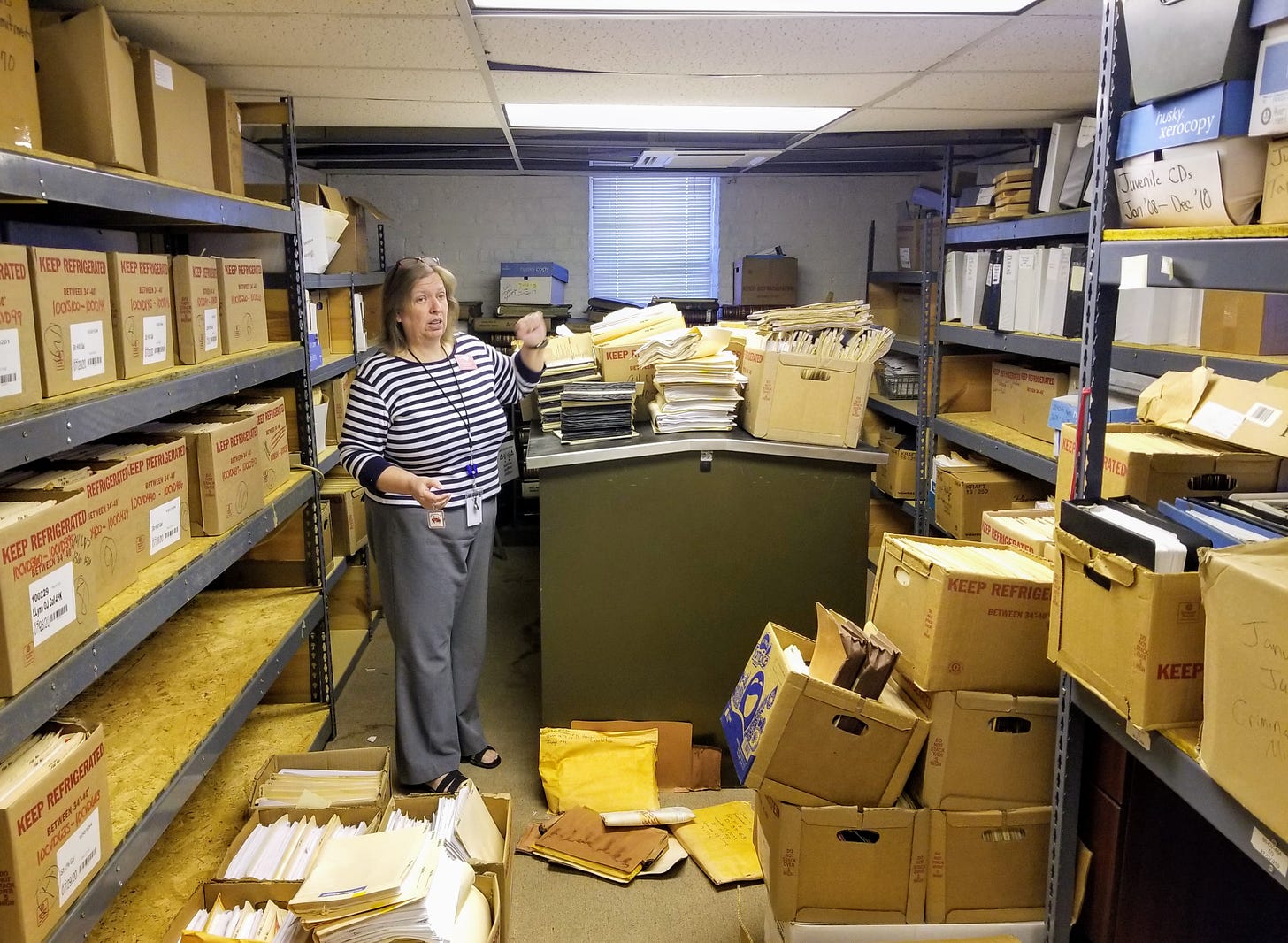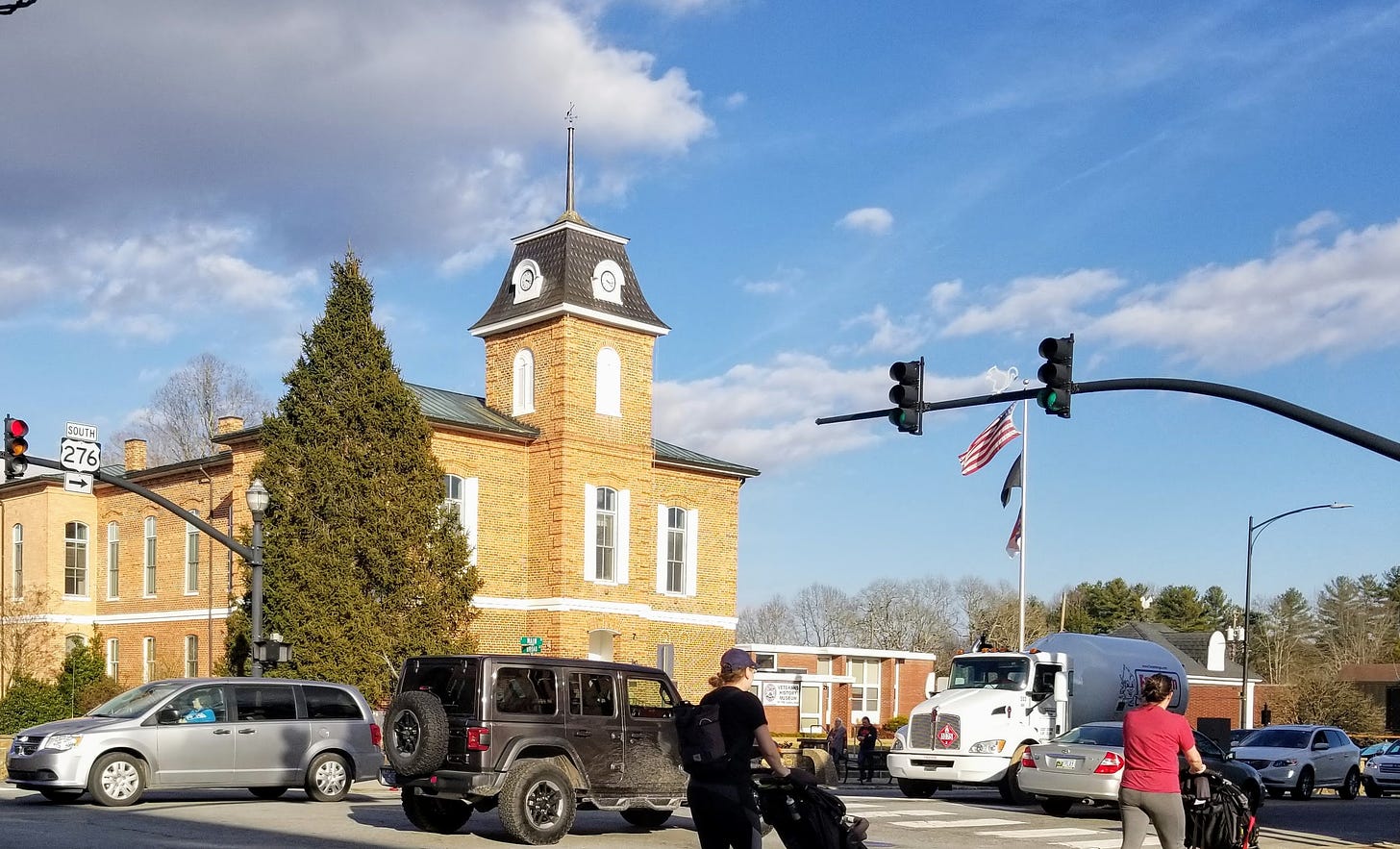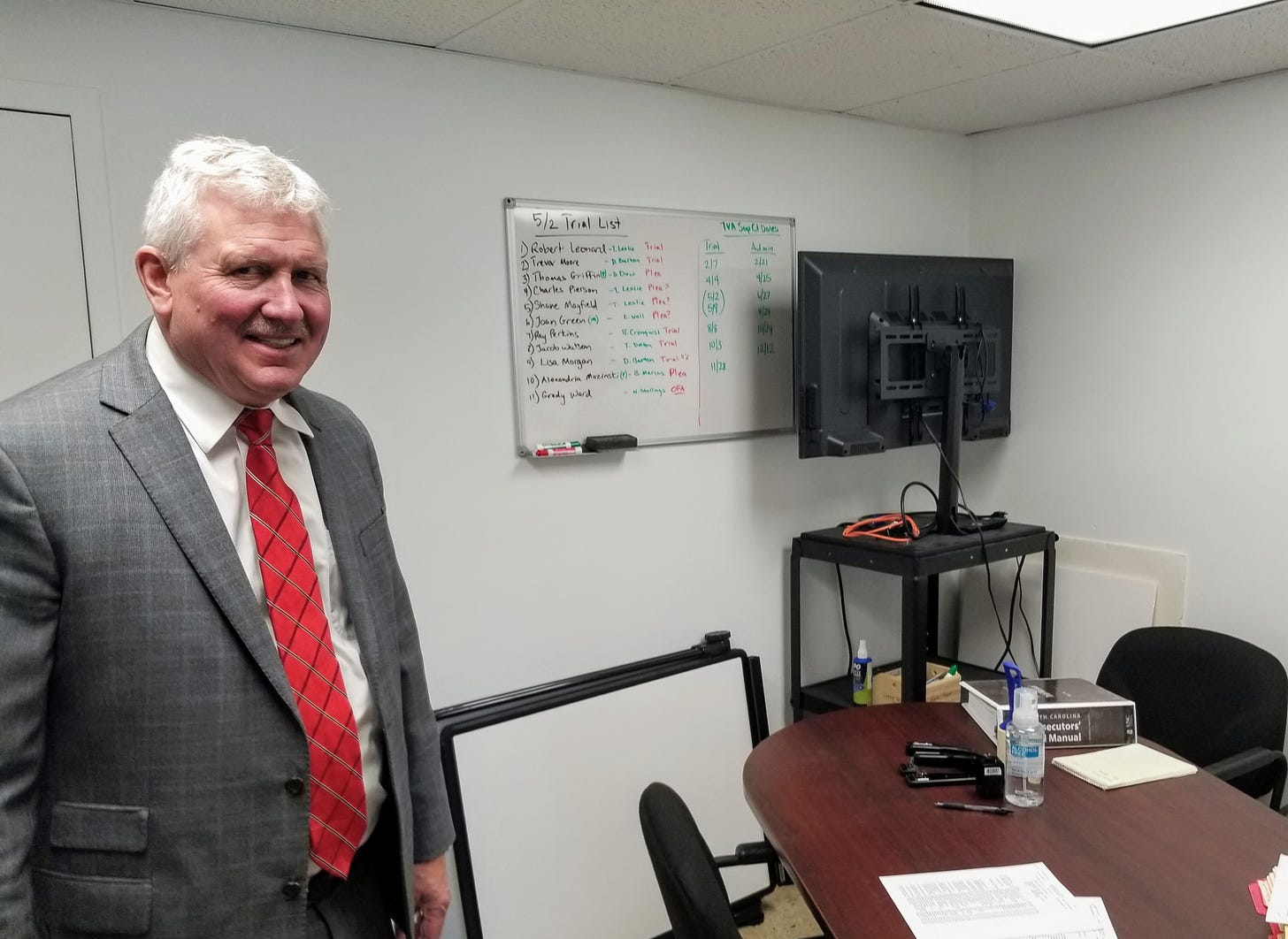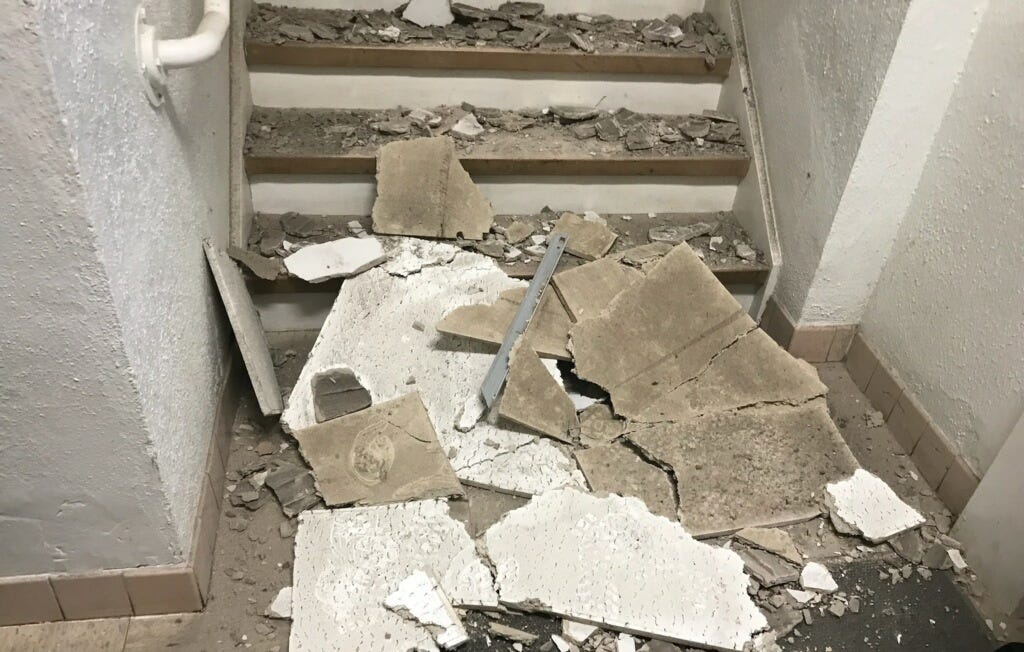Sewer Backup and Falling Plaster: Clerk Shows Courthouse is Unsafe to People, Legal Process
The cramped, crumbling conditions revealed during a tour of the Transylvania County Courthouse are not just unpleasant, officials say, they pose dangers to workers, visitors and the justice system.

BREVARD — Clerk of Superior Court Kristi Brown stood at the base of a steep, narrow staircase that serves as the only public path to the only functioning courtroom in the Transylvania County Courthouse.
“This is an area where victims and defendants can come into close contact with each other,” she said, as a lean young man in a black T-shirt began climbing the steps.
He stopped to glare at two young women as they brushed past him on their way down.
One woman responded with a series of groans: “Ugh. Mmm mmm mmm.” The other, sounding alarmed, said, “Whoa.”
“In fact,” Brown continued, “I think you might have just seen that happen.”
She witnessed this exchange during a two-hour tour of the building Thursday morning designed to press an argument that, in a way, she has already won.
The courthouse — the core of which was completed in 1881 — is so cramped and crumbling that it jeopardizes both the safety of all who pass through its doors and the integrity of legal proceedings, she said. And the need for a new courthouse is desperate.
No public official — and most significantly, no Transylvania County Commissioner — disputes this point. Commissioners have been discussing the construction of such a facility at least as far back as 2005. In 2018, they had lined up financing for a modern building, but backed off from approving it the the face of vehement opposition to its planned location, outside of downtown Brevard.
And at Monday’s meeting, after Brown and others pushed the Commission to renew these discussions, it tacitly agreed to County Manager Jaime Laughter’s proposal to address courthouse construction and other capital needs at a workshop later this year.
But just hearing about the building's problems hasn't conveyed their severity to the public, Brown said, after agreeing to show them off on Thursday. “A lot of people don’t have any idea about the reality and the logistics of what goes on in the courthouse.”
She opened the door to a basement records storage room recently flooded by a sewer backup, and to a room next to it crowded with discolored, effluent-tainted cardboard boxes.
“This is where I keep all the records that need to be sanitized,” she said.
She pointed to the base of the main stairway, where a 2019 ceiling collapse left a pile of “big, huge chunks of plaster,” she said. “You couldn’t get up the stairwell without climbing over it.”
She walked down a hallway crowded with members of the public on both sides of the 280 cases on that day’s circuit court criminal docket. She entered a jury room so small that it forces prospective jurors to wait outside its doors, where they are routinely passed by lawyers and witnesses in cases they might soon be hearing.
She toured a storage closet that doubles as a meeting room for lawyers and their clients and a law library that doubles as an inmate holding cell.
“Only when you lay eyes on these deficiencies can you really understand them,” she said.
“Staggering” Capital Needs

The expense of replacing the courthouse is daunting, but it is even more so in light of climbing construction costs, the limited financing options available to counties in North Carolina and the long list of Transylvania’s other unmet capital needs.
When the Commission debated the plan for the new courthouse in June of 2018, they referred to it as a “$31-million capital project.” Two years later, an architect hired to look at potential courthouse sites estimated costs ranging from $45 million to build near the current downtown location to $37 million on Morris Road near the public safety building.
The updated numbers for those sites, Laughter said this week, are $57 million and $44 million respectively.
Other big-ticket items on the county’s list include the $68 million school-renovation project, the bonds for which will be financed by a 2019 tax increase, and a new or rebuilt Blue Ridge Community College campus carrying an estimated price tag of $35 million.
But these are far from the county’s only needs, the total price for which came to $300 million when the Commission last held a capital workshop in March of 2021. By the time the country hosts the next such discussion, probably sometime this summer, Laughter said Monday, “I would not be surprised to see that number to be upwards of $400 million.”
“It’s staggering,” Commissioner David Guice said afterwards.
Some states allow counties a variety of funding options, including charging fees for new developments or tailoring property tax rates to ease the burden on working families and charge a premium on second homes.
That’s not true in North Carolina, where broadly applied increases in property tax rates stand as the Commission’s only real option to pay for capital improvements, Laughter said.
And it’s incorrect to assume that the county’s tax revenue is soaring along with home values, said Finance Director Jonathan Griffin.
Transylvania reappraises property for tax purposes every four years. When the total value of its tax base rose by $905 million during the reappraisal completed before the approval of the current budget, the Commission responded by lowering the tax rate from 64 cents to just over 60 cents for every $100 of appraised value, or slightly above the “revenue neutral” rate.
Such decisions have helped create the backlog of expensive projects, Guice said. “We take pride in saying we have one of the lowest tax rates in the state, yet we take money off the table that could be used to meet these needs.”
Transylvania’s rate is lower than the 2021 statewide average of nearly 68 cents, the most recent numbers available from the North Carolina Association of County Commissioners. But it’s slightly higher than the rates of nearby Henderson and Buncombe counties, which boast large tax bases that include the kind of high-value industrial properties the county is working to attract, Laughter said.
Without them, said Larry Chapman, the burden of paying for big projects will lie heavily on ordinary residents.
“I can give you anything you want, Mr. and Mrs. Citizen,” he said at Monday’s meeting. “But I’ve got to take it from you first.”
The “Broom Closet”

But the courthouse is not a want but a need, and its lack of space not just uncomfortable but legally hazardous, said Brown and District Attorney Andrew Murray, who joined her for part of Thursday’s tour.
In modern courthouse, inmates due to appear before a judge are driven to a separate, secure entry called a sally port. They are then led through a dedicated passageway and elevator to isolated cells, Murray said.
With only one entrance to the Transylvania courthouse, inmates must be brought to the jail before it opens and led through the same hallways and elevator as the public. During jury trials they are held in the second-floor law library just across from the often-overflowing jury room.
This raises not only security concerns, Murray said, but by increasing the likelihood that defendants will be seen by jurors, potential legal hazards.
“You’re trying not to taint a jury by allowing them to know defendants are jail inmates,” he said. “That goes by the wayside when the jury sees them transported in shackles . . . That right there would constitute a mistrial.”
After Murray entered the rear of the courtroom shortly before the start of Thursday’s session, he told Assistant District Attorney Lillie Jenkins that he was heading to a room where defense attorneys meet with their clients.
“Ah,” she said, arching her eyebrows, “the broom closet.”
He found no brooms but two ladders, an old filing cabinet and a battered desk covered by dust and a bundle of faded carpet. The room was narrow enough that Murray could extend both arms to touch opposite walls. The subdued murmuring from the crowd in the courtroom could clearly be heard through the closed door.
“The looks are not as much of an issue as that you can hear what’s going on out there,” Brown said, “And that means they can hear everything that’s going on in here.”
The same is true even in permanent offices, said Assistant Public Defender W. Thompson Leslie. “I’m pretty loud and I’m sure everyone walking down the hallway can hear what I’m saying.”
Another public defender, Mara Mayer, walked down a hallway with a wall patched by a four-foot high plank of poster board. Entering her office, she pointed out that it is too small to fit a standard L-shaped office desk or even one additional chair to allow her to sit with clients. This means meetings with defendants, some of them accused of violent crimes, are preceded by searches for unused rooms in the courthouse or even quiet spaces outdoors.
“Confidentially is something that is always pretty difficult for us to finagle our way around,” Leslie said.
Prosecutors are similarly cramped, Murray said, showing that lawyers work in cubicles rather than separate offices that would allow private conversations. The one small, cluttered room set aside for such meetings serves, during trials, as the office’s only waiting area for victims, including abused children.
Murray, whose district includes Polk and Henderson counties, also uses it as a workspace during visits to Transylvania.
“Let me show you my office,” he said, before opening the door. “I don’t have anywhere else to go.”
“It Could Have Been Horrible”
Crumbling and unsanitary conditions present more direct hazards to the well-being of courthouse workers and visitors.
If the ceiling above the stairs had fallen during a crowded court day rather than over a weekend, Brown said, “it could have been horrible.”
Melissa Moody, an assistant civil court clerk, was working in a file room during an earlier ceiling collapse, she said.
First she heard what turned out to be pebbles of plaster falling on the drop ceiling. “It sounded almost as if there could have been an animal up there,” Moody said. “But then there was this large crash.”
The sound was alarming enough that she and another clerk rushed from the room. Later, when she saw that only flimsy ceiling tiles had prevented plaster slabs from falling into the workspace, she said, “that was actually more frightening.”
The backed-up sewage, filtering up from the floor of a basement storage room during a murder trail four weeks ago, initially smelled like water, Brown said. County maintenance workers installed a sump pump, but two days later, she said, “We came back down here and the water is out in the hallway.”
That led to the discovery of a line clogged with old rags, she said, and “when (a worker) let loose of that you definitely knew it was sewage.”
Though the mess has since been cleaned up and the pipe capped, the moist and closed conditions in the basement rooms cause sneezing and congestion even in normal times, Brown said.
And since the sewer spill, “it’s just eww,” assistant clerk Rebecca Hall told commissioners Monday. “When we go down there to get files, because we do have to get files, I have literally sprayed Lysol on the bottoms of my shoes.”
What It Says About the Justice System
The conditions in the courthouse also generate a more abstract concern, but one that is very real to people who work there: the message this sends about the county’s commitment to the judicial system.
“Courthouse conditions have an effect on the attitude of the persons present,” now-retired Senior Resident Superior Court Judge Mark Powell wrote in a 2015 letter to commissioners.
Jurors are more focused and defendants more respectful in adequate court facilities, he wrote. “I believe it is because they realize the judicial process is being taken seriously.”
Adequate conditions are not present in Transylvania and haven’t been for many years, Brown said. Though a timeline of this issue on the county website dates back to 2005, several commissioners have said it was frequently discussed in the previous decade and Brown provided a statewide study from 1979 that ranked the structure’s “overall physical condition” 85th among North Carolina’s 100 county courthouses.
The Commission has, in two previous years, raised the property taxes that generate $2.4 million annually for the courthouse and other capital projects, Griffin said.
And, Laughter wrote in an email, the consideration of major capital needs, which require long-term planning, is separate from the discussion of the budget for the upcoming fiscal year that “addresses funds to be spent in the next year for operating and minor capital.”
But commissioners know they must raise money for the courthouse, Guice said. The need is that obvious, the action that long overdue. The sooner they address it, the sooner the necessary funds will begin to accumulate.
“I will be pushing in the direction of addressing some of those needs” during the budget discussion, he said. “We have to do that now.”
Email: brevardnewsbeat@gmail.com




So, if a potential juror who uses a walker needed to get to a courtroom, would an elevator be available? Asking for a friend…